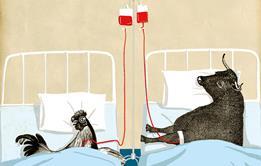This is story is part of our 2016 Meat, Fish & Poultry digital feature.
Pork prices have plummeted 6% over the past year as the impact of the Russian import ban, which came into force in August 2014, deepens [Kantar Worldpanel 52 w/e 22 May 2016].
The drop in price hasn’t helped boost sales of the UK’s third bestselling meat as value fell 9.5% on volumes down 3.7%, wiping £74.7m off sales.One of the driving factors behind the price decline is the Russian ban, which led to an oversupply on the market.
“Pork prices have suffered a deflationary effect for the past two years and, by March 2016, the price the producer was receiving was the lowest in eight years,” says Vikki Campbell, senior analyst in market intelligence at AHDB.
“There was an oversupply of pork on the UK and EU market, and this was not matched with an increasing demand. This oversupply was compounded by the Russian ban, which caused a flood of pork on to the EU market, at a time when production levels were increasing.”
Things are recovering, says Campbell, noting how the oversupply has been diluted by increasing exports to the Far East, which has also helped support prices.
“Traditionally, pork responded well to x for y deals. Removal of this promotional mechanic coincided with a fall in pork volume sales”
Changes to the promotional mix, as well as a move towards convenience, affected volumes on top of this. “Retailers are moving away from x for y deals and focusing on everyday low prices or temporary price reductions,” she says.
“Traditionally, pork responded well to x for y deals. However, removal of this promotional mechanic coincided with a fall in pork volume sales. Consumers are now moving towards smaller households who are looking for quick, easy meal solutions. Pork does not feature strongly within convenience, where it can be argued that poultry has stolen a march.”
“The current pulled pork campaign has now run its course but marketing will continue. The main aim is to rejuvenate its image and encourage more people to try more pork”
AHDB tried to inject value back into pork with its pulled pork campaign by promoting a cut – pork shoulder – that has traditionally been less in demand and encouraging consumers to buy it more regularly. This in turn, says AHDB, had a “halo effect” on the fresh pork market.
“The current pulled pork campaign has now run its course but marketing will continue. The main aim is to rejuvenate the image of pork and encourage more people to try more pork,” says Mick Sloyan, strategy director, AHDB Pork. “We have made a good start but there is still a long way to go.”
Previous article - Global meat & fish NPD: Unprocessed trend sweeps planet
Next article - Revealed: supply chain wastes equivalent of 267,000 cows
10 Things You Need To Know About... Meat, Fish & Poultry

For the latest in our series of ‘10 Things…’ digital features we’re serving up a piping hot portion of news, views, exclusive research and trends analysis from Britain’s meat, fish & poultry market…
- 1
- 2
- 3
- 4
- 5
- 6
- 7
 Currently
reading
Currently
reading
Pork prices continue to plummet after Russian ban




























No comments yet